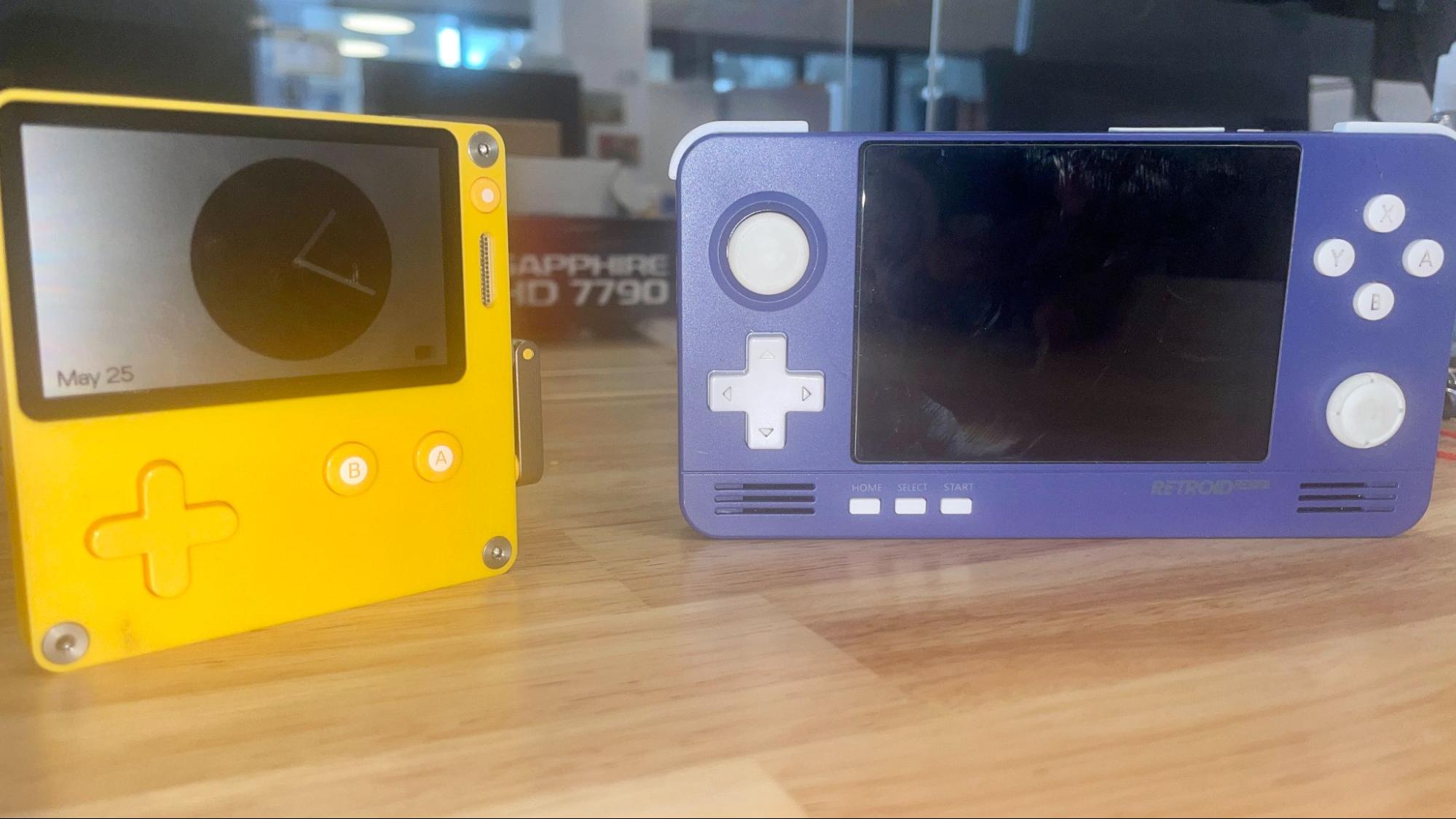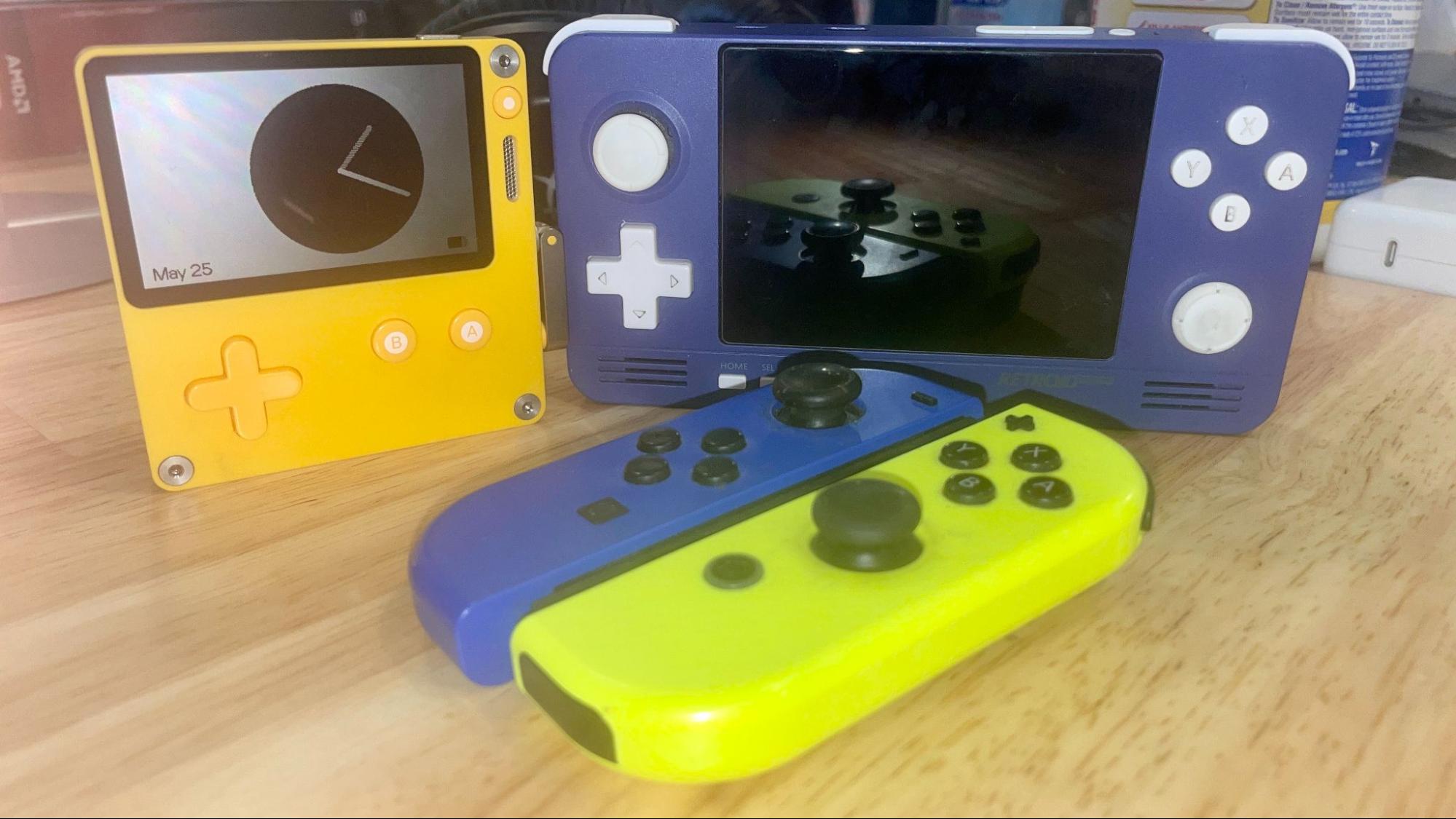Tom's Hardware Verdict
The Playdate offers a unique, portable play experience, complete with a series of indie games. But at $179 for a monochrome console with just a few games, it’s too expensive for what you get.
Pros
- +
Unique controls
- +
Has a handful of fun, distinctive games
- +
Great design
Cons
- -
Too expensive
- -
Screen hard to read indoors
- -
Not all games are created equally
Why you can trust Tom's Hardware
The Playdate is the latest mobile gaming device on the block and serves as the first mobile device from Mac software publisher Panic. Panic is known for publishing games like Firewatch and more recently, the indie darling Untitled Goose Game. Separating itself from retro emulation consoles and Steam Deck imitators, the black-and-white screened Playdate utilizes two buttons, a directional pad, and a mechanical crank (yes, a crank) that serve as the main controls for most games. The crank is a major selling point as it allows for different game mechanics – for example, a fishing game where you have to reel in your catch.
And as the device’s name suggests, the Playdate will deliver a weekly scheduled release of games developed by indie studios around the world. These devs include Diego Garcia (Casual Birder), Katamari Damacy's Keita Takahashi (Crankin’s Time Travel Adventure), and Bennett Foddy (Zipper), to name just a few.
These 24 games, published by Panic, are sent over Wi-Fi and packaged as seasons. As of now, Season One has released 10 games. Panic’s mission is to use the Playdate as a vessel for some of the most innovative monochrome indies around. But you really have to love the indie spirit, cute yellow chassis, and crank to justify paying $179 for a black and white handheld with only a few games.
Design of the Playdate


The Playdate is a 2.99 x 2.91 x 0.35 inch (76 × 74 × 9 mm) yellow box with a directional pad, two A/B buttons, a home button on the top left next to the display, and a lock button on the top. On the side is its unique crank, which also has a little pocket to tuck away its handle. You spin it around in a circular 360-degree motion and it can serve a myriad of functions depending on the game you’re playing. There is a small, silver mono speaker on the side below the home button that’s more powerful than you may expect, which is a good thing.
On the bottom of the unit are a USB-C charging port and a 3.5mm headphone jack. A yellow USB-C to USB-A cord comes in the packaging.


There are three little holes in each corner but the top-left, which can be used to loop something through it and make the Playdate into a cute keychain or wearable accessory.
The Playdate is nice and pocket friendly. It hardly weighs a thing at 0.18 lbs (86 grams) and as such, is a nifty little gadget to whip out during your commute to work or school. I’ve got giant mitts for hands and the corners on the Playdate are pretty sharp. So sometimes my grip wasn’t as secure or comfortable as I would have liked when using it. When I played games that utilized the crank heavily, I sometimes couldn’t see the display very clearly since the unit moves around while cranking.
Get Tom's Hardware's best news and in-depth reviews, straight to your inbox.
Playdate Specifications
| CPU | Cortex M7 SDK (168 MHz) |
| Memory | 16MB RAM |
| Storage | 4GB flash storage |
| Display | 400 x 240, 1-bit monochrome, sharp memory display |
| Networking | 802.11bgn (2.4GHz) Wi-Fi, Bluetooth 5.2 |
| Ports | USB (Type-C), 3.5 mm headphone jack |
| Power Adapter | USB-C to USB-A Cable |
| Dimensions (WxDxH) | 2.99 x 2.91 x 0.35 inches (76 × 74 × 9 mm) |
| Weight | 0.18 lbs (86 grams) |
| Price (as configured) | $179.99 |
Display on the Playdate
The Playdate has a 1-bit black and white 2.99 x 2.91 x 0.35 inch (76 × 74 × 9 mm), 173 ppi sharp memory display with a 400 x 240 resolution, and a 5:3 aspect ratio. The screen delivers wonderfully sharp black and white visuals that use a dithering technique to achieve the appearance of grayscale. The sharp display immediately struck me as soon as I powered the device. When I started playing games, I couldn’t help but appreciate how crisply the display conveyed the black and white retro art style of each title.
But after a while, I began to notice some flaws with the device’s display. There’s a fair bit of bezel surrounding the display that I question the necessity of. It’s not like the bezel gets in the way of any game or would improve its gameplay in any way. But with such a small gadget, any extra screen real estate is appreciated nonetheless.
But more importantly, this screen desperately needs a backlight. The display is great for outdoor use on a sunny day, but barely visible in any dimly-lit area. It's an issue I haven’t faced with a handheld gaming device since I was a young child with a Gameboy Color. I constantly found myself having to tilt the Playdate slightly toward a light source in order to see what the screen displayed. Despite having a well-lit office, my coworker and I found ourselves having to get directly under an overhead lamp to see games clearly. I suspect it would affect the Playdate’s power, which lives up to its claims of a 14-day standby and 8 hours of active battery life.
Gaming on the Playdate
There’s a fairly long setup process for the Playdate that forces you to add an email address to even activate the device, which I found annoying and slightly invasive. After charging it up, waiting for the updates, downloading games, and the software updates for those games, you’ll be ready to finally play with the Playdate.
I’ve played a fair amount of most of the games available in the first season, and I enjoyed a lot of them. Nearly all the games attempt to utilize the crank in some way. Certain games excel at the crank implementation creatively, such as Casual Birder, Omaze, and Hyper Meteor. There are other games like Whitewater Wipeout and Time Travel Adventures that overly rely on the mechanic. Then there are a few that ignore the crank entirely for better or worse and even find shallow reasons to undock it.
There’s a mixture of casual games and narrative-based games on the device like Lose Your Marbles and Echoic Memory, but Casual Birder may be my favorite of that mixture. There’s not a lot of dialogue or setup to the narrative and it keeps the story simple, yet intriguing. You’re the new kid(?) on the block in a neighborhood obsessed with bird watching. Using the crank to focus your whacky camera, you must line up a perfect shot of your prey as it flies around its terrain. It’s a unique mechanic for the crank and one of the best utilizations I’ve seen from it. You could get lost collecting pictures for your scrapbook and you’ll gain some information about various birds as time passes.
Omaze is another game that utilizes the crank nicely, but it has gameplay you’d expect to see from a mobile system that uses a crank as its main gimmick. You use the crank to spin a wheel that makes a small ball journey from point A to point B. It’s a cool game with straightforward mechanics.
Hyper Meteor has similar gameplay, except that you’re controlling a floaty spaceship in zero gravity space, hitting meteors in specific spots to stay alive. Both games are great, pick-up-and-play titles to enjoy during a commute.
Then there are titles like Whitewater Wipeout and Time Travel Adventures that solely use the crank in a way that you wouldn’t want to be seen doing in public. The former sees you carefully controlling the momentum of a surfer, riding waves, and doing flips for points. The latter sees a sad creature running to make a date he’ll never have and you control the speed of his movements via the crank and avoid obstacles on the way.
Cranking can get frantic in these games. And although the Playdate is a small, inconspicuous device, you will look like a weirdo overly cranking in your seat in public as these games demand. Plus, both games lose their luster after a short time. The gameplay never evolves past the first few minutes, and only gets more difficult and frustrating.
My favorite game on the Playdate, Flipper Lifter, solely utilizes the crank to move an elevator up and down floors to get the penguins in the building to work, or wherever they’re going. Cranking can get frantic here as well, especially as the number of penguins begins to affect how fast the elevator moves. But it’s such a unique take on the crank mechanism that I don’t mind looking weird on the subway when I play it.
Games like Pick Pack Pup and Boogie Loops don’t even bother with the crank and utilize the buttons and d-pad. Boogie Loops doesn’t lose anything by not using the crank, since it's basically a limited beat-making software. But Pick Pack Pup forces players to undock the crank in order to progress through cutscenes with no other use for it than that, which I found to be annoying. But otherwise, it was one of my favorites to play.
It’s also worth noting that a fair share of games don’t come with any sort of gameplay instructions. For some games like Omaze, the mysterious allure of its title card among the list of games to play and the way it drops you into the action work toward its mysticism. But other games like Zipper, a turn-based samurai puzzler, could really benefit from instructions.
If you use the charger for the Playdate to hook it to a computer and download Panic’s Mirror software, you can play games on the big screen. The application emulates the Playdate digitally and you can choose to use a mouse and keyboard for movements. Or you can use a controller. But it doesn’t feel organic, and I could only see using it to show off the gadget online via a stream or for recording demonstration footage.
Bottom Line
The Panic Playdate is a great mobile indie game console with quirky games from many unique developers I’ve never heard of. The inclusion of the crank elevates the device from being just another flash-in-the-pan gaming device and its approach to releasing software ensures there will be new experiences to have as time goes on. It has a cute, yellow, compact design that makes it look like a fashion accessory and, if it’s in the right lighting, its screen makes the black and white art style of each game pop.
But $179 dollars is a lot to pay for this kind of novelty. A retro handheld gaming fan might prefer to spend $40 more for the Analogue Pocket, a Gameboy-compatible handheld with a fantastic color screen. Or one could spend just $20 more and score a Nintendo Switch Lite which has a huge ecosystem of very advanced games.
Neither the casual pick-up-and-play style titles nor the finely balanced narrative titles captured my attention long enough for me to invest this much money on it. Maybe if I were a big indie game enthusiast who loved supporting indie devs and creators in the space, and I wanted to support some folks doing good work, I’d invest.
But if I’m just a regular person on a budget looking for a mobile device to play games on from time to time, I may be a bit more concerned about which games I can play on it and whether I’d like those games. With the Playdate, you don’t know if you like their onboard games until you actually play them. And if you don’t, there goes another title on this device you’ll be ignoring in favor of the few you like. That’s a lot of money to just rely on good faith that you’ll maybe enjoy the games that’ll roll out for it. And for nearly $200, the Playdate should have a backlight for that screen and maybe Bluetooth headphone support, if I’m being picky.

Isaac Rouse is a staff writer at Tom's Hardware. He reviews laptops and various gaming peripherals.
-
Giroro The original Gameboy could display 4 shades: Black, "White", and 2 shades of gray.Reply
The playdate.. Can't do that.
I get that the extremely limited display mixed with the extremely limited controls are there to inspire developer creativity, but they've gone too far. There are many types of creative "crank based" game ideas that simply will never work on the console.
Somebody will probably still attempt to make a crankable fighting game, for example. But a fighting game will either be too simple to be fun, or too complicated to see what's happening on screen.
The same goes for many other genres.
So what you end up with is one trick gimmick device. Stuck with a handful of shallow titles, which rarely even attempt to go much deeper than a warioware micro game. That kind of thing is worth $20, not $200.

